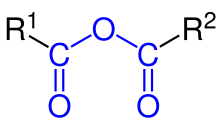
An organic acid anhydride is an acid anhydride that is also an organic compound. An acid anhydride is a compound that has two acyl groups bonded to the same oxygen atom.[1] A common type of organic acid anhydride is a carboxylic anhydride, where the parent acid is a carboxylic acid, the formula of the anhydride being (RC(O))2O. Symmetrical acid anhydrides of this type are named by replacing the word acid in the name of the parent carboxylic acid by the word anhydride.[2] Thus, (CH3CO)2O is called acetic anhydride. Mixed (or unsymmetrical) acid anhydrides, such as acetic formic anhydride (see below), are known, whereby reaction occurs between two different carboxylic acids. Nomenclature of unsymmetrical acid anhydrides list the names of both of the reacted carboxylic acids before the word "anhydride" (for example, the dehydration reaction between benzoic acid and propanoic acid would yield "benzoic propanoic anhydride").[3]
One or both acyl groups of an acid anhydride may also be derived from another type of organic acid, such as sulfonic acid or a phosphonic acid. One of the acyl groups of an acid anhydride can be derived from an inorganic acid such as phosphoric acid. The mixed anhydride 1,3-bisphosphoglyceric acid, an intermediate in the formation of ATP via glycolysis,[4] is the mixed anhydride of 3-phosphoglyceric acid and phosphoric acid. Acidic oxides are also classified as acid anhydrides.
- ^ IUPAC, Compendium of Chemical Terminology, 2nd ed. (the "Gold Book") (1997). Online corrected version: (2006–) "acid anhydrides". doi:10.1351/goldbook.A00072
- ^ Panico, R.; Powell, W. H.; Richer, J. C., eds. (1993). "Recommendation R-5.7.7". A Guide to IUPAC Nomenclature of Organic Compounds. IUPAC/Blackwell Science. pp. 123–25. ISBN 0-632-03488-2.
- ^ "Nomenclature of Anhydrides". 8 November 2013.
- ^ Nelson, D. L.; Cox, M. M. "Lehninger, Principles of Biochemistry" 3rd Ed. Worth Publishing: New York, 2000. ISBN 1-57259-153-6.